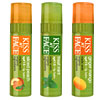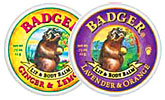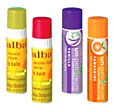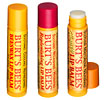
When it comes to lip balms, I have a long and sordid history. It reaches back to the early 1980s when, as a young and curious grade-schooler, I would sneak into my sister’s bedroom to absorb what it meant to be old and glamorous. She, you see, was in high school — an unthinkably advanced station in life — and I was mesmerized by the assortment of tubes, bottles, and jars on her bureau. One of those was a cherry-flavored Bonne Bell Lip Smacker. For a full explanation of the allure of this product, let us turn to an ad in Tiger Beat magazine, circa 1979: “Not only are they the original humongous lip gloss, but they’re the niftiest too.”
Nifty indeed. And so irresistible that one day I progressed from simply sniffing the BB essence to — well, eating it. I took a big bite of that Bonne Bell, and I still recall the horror with which I realized that below the cherry exterior lay a waxy substance with no resemblance to fruit.
Grist’s Pick
Isn’t it time to break the addiction?
That’s true of many lip products, both then and now (including Bonne Bell, which is still pushing Smackers — who knew!). Deceptively sweet on the outside, they contain a concoction of chemicals. Some say the nefarious ingredients therein actually create an addiction of sorts (it has even been called “the dependency problem of the new millennium“). If that’s not scary enough, one of the companies below says we eat pounds of the stuff over a lifetime. Ieuw.
Between concerns about chemicals and the chance of making a sweet buck (Americans spent $378 million on lip balms in 2007), it’s no wonder that an organic and natural balm sector is popping up. But do the suckers really work? Five Grist staffers — in the grips of winter in the Northeast, Southeast, and Northwest — tried a few to find out. Join us as we wax poetic.

Kiss My Face Lip Balm
Flavors tested: Sliced Peach, Ginger Mango, Treat Mint
Eco-claims: Made with organic ingredients
SPF: Yes, 15 (and a KMF sport stick has 30)
Price: $2.99-$3.25/0.15 oz.
One tester said Kiss My Face “wins, hands down,” with the smoothest texture and longest-lasting effect: “I put it on before bed, and my lips still felt greased in the morning.” But not everyone was similarly smitten: The sliced peach flavor had a strong smell, was deemed “a touch oily,” and didn’t last as long as its competitors. Another tester found that the ginger mango stick, despite a “yummy” scent, “goes on waxy and actually felt drying as I wore it.” And the SPF in this line of sticks nets ugly ratings from the EWG Skin Deep Database.

Badger Lip & Body Balm
Flavors tested: Lavender & Orange, Ginger & Lemon
Eco-claims: USDA Organic
SPF: Not in these, but in an SPF 15 stick
Price: $4.99/0.75 oz
Whatever the flavor, this balm smells great, with scents that are at once soothing and refreshing. One tester said she’d “wear it even if I wasn’t chapped,” but noted that “it’s thin and gets sucked up into the skin quickly.” I’ve found, and another tester agreed, that the balm doesn’t stay on for very long, though she reported that her lips were “significantly softer after a few days of use.”

Desert Essence Lip Rescue
Flavor tested: Eco-Harvest Tea Tree Oil
Eco-claims: No animal ingredients or testing
SPF: No
Price: $2.39/0.15 oz.
No subtleties here: One tester said “this stuff smells like turpentine,” while another described “a piney scent, a little like a fresh mop bucket about to be used to swab out a bathroom.” Yum! Despite the powerful odor and a tingle upon application, both testers praised the cold-weather performance of this balm, one of the few in this lineup to not contain organics. Though it works, one tester noted wryly, “I’m not sure if I’d like to kiss someone who smells like turpentine.”

Alba Lip Balm
Flavors tested: Coconut Cream, Pineapple Quencher, Passion Fruit Nectar; Un-Petroleum Tangerine
Eco-claims: Made with organic ingredients, 100 percent vegetarian ingredients; no animal testing
SPF: 18 (in the un-petroleum line and a separate “lipcare” stick)
Price: $3.39/0.15 oz.
These super-fruity balms seemed to transport their users: “The sweet coconut scent made me think about warm tropical breezes even as Seattle’s ‘Snowmageddon’ raged outside,” said one, and I was brought right back to Bonne Bell days. Though the balms were effective, users noted a waxy feel and taste; a slightly different design — with the dial toward the top of the tube — could leave cold hands fumbling. (And watch out for the long ingredient list: hello, ammonium glycyrrhizate.) The Un-Petroleum stick, while slightly cheaper ($2.49) and boasting SPF 18, “doesn’t offer much else,” said our tester. “I found myself reapplying often and it doesn’t go on as smooth as the others.”

Burt’s Bees Lip Balm
Flavors tested: Honey, Beeswax, Replenishing with Pomegranate Oil
Eco-claims: Tube contains 50 percent post-industrial recycled plastic; not tested on animals; 95-99 percent natural (depending on flavor)
SPF: Not in these, but in Burt’s Res-Q Balm
Price: $3.00/0.15 oz
These widely available “natural” balms garnered mixed reviews: praise for mild aromas, but pans for a “gummy” and surprisingly strong feel. I can attest that with seriously chapped lips, the “pleasant tingle” one tester noted of the Beeswax flavor becomes excruciating. Burt’s Replenishing balm got props from one tester for providing the promised extra moisture, and
“a bit of pinkish coloring to my winter lips.” But the honey and replenishing sticks both contain the dread “fragrance,” which can mask toxics in cosmetics. On the plus side, Burt’s is the only brand that uses recycled plastic in its tubes — or the only one that boasts about it.

Dr. Bronner’s & Sun Dog’s Magic Organic Lip Balm
Flavor tested: Naked
Eco-claims: USDA organic, not tested on animals
SPF: No
Price: $2.79/0.15 oz.
Like the name says, this offering from everyone’s favorite cosmetics nutcase is pretty naked — just five ingredients (one of the shortest lists of the bunch) and not much in the way of taste or smell, except a very slight hint of lemon. Our tester found that the balm, which comes in several other flavors as well, went on very smooth, but required more re-application than some.
BeeCeuticals Organics Bee-yond Lip Balm
Flavor tested: Natural
Eco-claims: USDA organic, Fair Trade certified ingredients
SPF: No
Price: $3.99/0.15 oz.
This balm had a weird waxy-looking layer on top, said one tester, but it actually went on surprisingly smooth. With not much taste and just a slight lemony scent, it was “definitely the most silky-feeling of the bunch and left my lips well moisturized.” It’s also the only one that boasts Fair Trade certification. However, its short and sweet ingredient list is countered by a comparatively high price tag.

Eco Lips
Flavors tested: Hemp/vanilla, Sport
Eco-claims: 95 percent organic, cruelty-free, non GMO, petroleum free; also makes a vegan, bee-free stick
SPF: 30 (Sport); some flavors have SPF 15
Price: $2.49/0.15 oz.
I have a personal bias toward this balm, which I picked up at an outdoor-sports store several years ago. It was the first balm that ever worked for me. Oddly, I had forgotten about it until this story came up — now I’m in love all over again. The hemp-vanilla variety is creamy and moist, with a sweet, mossy smell and taste; though I needed to reapply almost immediately, the second time was long-lasting. The Sport stick brings the tiniest taste of sunblock (and it should be noted that, while EWG likes this one, it is not keen on another SPF offering from the company). And for the vegans out there, Eco Lips tells Burt where to go with a “bee-free” stick.

Avalon Organics Vitamin C Soothing Lip Balm
Eco-claims: Made with organic ingredients, 100 percent vegetarian ingredients, no animal testing, E.U. compliant
SPF: No
Price: $4.95/0.25 oz.
A bigger-sized tube than the others makes this not so convenient for slipping into a pocket, and the location of the dial at the top could prove a problem for people who are all thumbs. The balm goes on thick and stings slightly, and the smell transported me back to a grade-school candle-making class. In all, not the most positive experience.
The Bottom Line: Of the nine balms tested, the top picks for performance were Alba, Burt’s, Eco Lips, and Kiss My Face. But each has complications when it comes to the ingredient list. So shop with care, consider making your own balm, or do your best to break the addiction!
Special thanks to testers Tom Philpott, Kate Sheppard, Trina Stout, and Sarah van Schagen.


